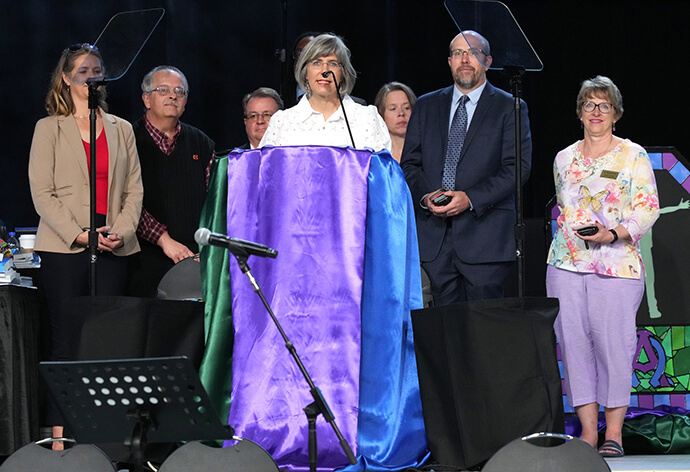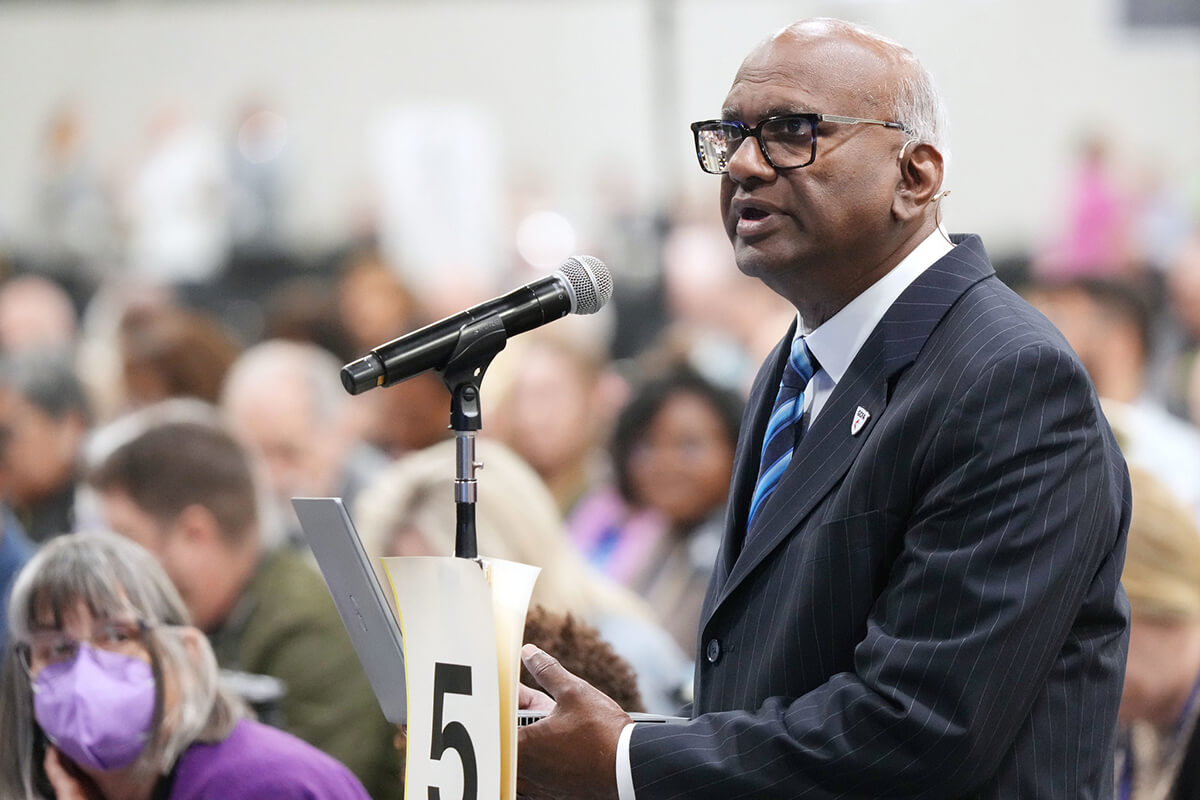Key points:
- General Conference delegates passed a denominational budget that represents a 38% to 41% cut to the budget the 2016 General Conference passed.
- The ultimate bottom line is contingent on giving rates in 2025 and 2026.
- Delegates also approved a plan for distributing 32 bishops across the U.S. — which represents a reduction from the 39 active bishops currently serving.
General Conference delegates on May 3 approved a denominational budget with a bottom line that will vary by about $20 million, depending on giving collection rates over the next two years.
But no matter what happens, the total budget will be significantly smaller than what General Conference approved in 2016, and annual conferences will be asked to pay less to support denomination-wide ministries.
By a vote of 647 to 31 (a 95% majority), this year’s delegates approved a 2025-2028 denominational budget of $373.4 million. That total is contingent on collection rates being at 90% or more for the next two years. If giving is below that percentage, the budget bottom line will be $353.6 million.
What that means is that the budget will be between 38% and 41% lower compared to the $604 million budget the 2016 General Conference approved.
The budget cuts come after a quarter of U.S. churches have withdrawn during the previous four years. The church in the United States provides the bulk of financial support for denomination-wide ministries.
But after such tumult, the Rev. Moses Kumar, the top executive of the General Council on Finance and Administration, told delegates he hopes to see conferences achieve that 90% giving rate while also being able to retain more funds for local ministries.
“We are committed to trust in God that our members will support the church with their prayers, presence, gifts, service and witness,” he said. “Together, we hope to achieve a combined 90% collection rate in 2025 and 2026. This isn’t about funding and financial support. This is about ministry and mission.”
General Conference — the denomination’s top policymaking body — establishes the total amount of money needed to support churchwide ministries. That amount is then apportioned mainly to U.S. annual conferences, which in turn ask for apportionments — shares of church giving — from local churches.

Why budget varies
The variation in budget is due to action General Conference took on April 30. That day, delegates voted to reduce the base rate — a key component of calculating annual conference apportionments.
The current base rate is 3.29%. Delegates voted for that base rate to go down to 2.6% in 2025 and 2026. They also voted to potentially raise the base rate to 2.9% in 2027 and 2028 if apportionment giving rates are at 90% or above. No matter what, annual conferences will be asked to pay lower apportionments than under the 2016 budget.
In the U.S., the formula for determining an annual conference’s apportionments is its total local church net expenditures multiplied by a General Conference-approved base rate.
Net expenditures are what a church spends after capital expenses, apportionments and benevolent giving. Put another way, the fewer local churches there are, the lower the net-expenditure side of the ledger. Conversely, the more local churches there are, typically the higher the net expenditures.
Thus, collections rates are not the only way the budget could change. Fluctuations in net expenditures also ultimately change the budget’s bottom line.

What this means for various funds
U.S. conferences distribute their apportionments among seven general-church funds. Each fund supports a different category of ministry: bishops, ministerial education, general administration, the Black College Fund, Africa University, ecumenical work and the World Service Fund, which supports the work of most general agencies.
Central conferences — church regions in Africa, Europe and the Philippines — have their own formula for paying apportionments. Central conferences also only contribute to the Episcopal Fund that supports bishops and the General Administration Fund that supports global administration, including General Conference itself.
Because of the varied budget, allocations for the seven general-church funds also vary depending on giving rates.
Here is what General Conference approved:
Subscribe to our
e-newsletter
- $167.5 million or $158.5 million for the World Service Fund that supports most of the denomination’s 13 general agencies (including United Methodist Communications, which encompasses United Methodist News)
- $87.4 million or $82.8 million for the Episcopal Fund, which supports active bishops, their support staff, retired bishops, surviving spouses and minor children of deceased bishops
- $57.9 million or $54.8 million for the Ministerial Education Fund that supports United Methodist seminaries and provides financial aid for United Methodist seminary students
- $23.1 million or $21.8 million for the Black College Fund that supports 11 United Methodist-related historically Black colleges and universities in the U.S.
- $30 million or $28.4 million for the General Administration Fund, which supports General Conference, Judicial Council, the United Methodist Commission on Archives and History, and the General Council on Finance and Administration
- $5.2 million or $4.9 million for Africa University, a pan-African United Methodist university in Mutare, Zimbabwe.
- $2.4 million or $2.3 million for the Interdenominational Cooperation Fund, which supports the church’s ecumenical work.
Allocations for all funds represent decreases from what the 2016 General Conference approved.
The Interdenominational Cooperation Fund is seeing the steepest cut of between 70% and 72%. That’s because over the decades, the fund has accrued sizable reserves that previous General Conferences had tied up for purposes no longer needed.
What General Conference did during the morning plenary is free up those reserves so the denomination’s ecumenical leaders could use them for maintaining ecumenical and interreligious activity and relations. That means supporting United Methodist involvement is such groups as the National Councils of Churches, the World Council of Churches, the Pan-Methodist Commission and the World Methodist Council.

General Conference photos
Distributing bishops
But before the delegates voted on the total budget, they voted to set the number of U.S. bishops at 32.
That marks a decrease from the 39 active bishops currently serving in the U.S. and the 46 included in the budget approved by the 2016 General Conference.
Earlier in the week, General Conferences approved adding two bishops to the African continent, bringing the total to 15. But that decision came after long debate about missional needs vs. financial realities.
Over the past week, a group called the Interjurisdictional Committee on the Episcopacy has been trying to hash out how many bishops the U.S. should have — based on what the denomination can afford and how those episcopal leaders should be distributed among the jurisdictions.
By a vote of 631 to 65, delegates supported the committee’s unanimous recommendation for the following distribution of U.S. bishops:
- Southeastern Jurisdiction: Nine
- Northeastern Jurisdiction: Six
- North Central Jurisdiction: Six
- South Central Jurisdiction: Six
- Western Jurisdiction: Five
The Rev. Kim Ingram, the chair of the interjurisdictional committee and a delegate from the Western North Carolina Conference, noted that this drop in bishops would mean no elections for new U.S. bishops to replace the currently expected seven retirements. It also would mean reducing bishops by natural attrition.
“We recognize the need for a runway in the next four years during which the work could be done to explore the function of the episcopacy, our ongoing financial capacity and to live into regionalization.”
But she and others acknowledged this would require sacrifice. To reach this distribution, the Southeastern, North Central and South Central jurisdictions each will see one of their bishops transferred. Two bishops will go to the Western Jurisdiction and one to the Northeastern. Ingram said the interjurisdictional committee will work with bishops to find out who might be willing to transfer.
“Our priority will be to do no harm,” she said.
Hahn is assistant news editor for UM News. Contact her at (615) 742-5470 or newsdesk@umnews.org. To read more United Methodist news, subscribe to the free daily or weekly Digests.



